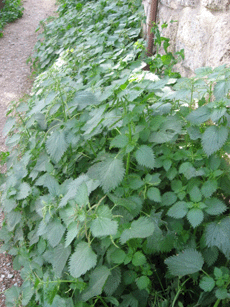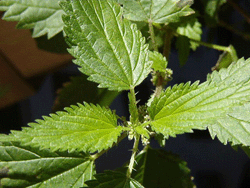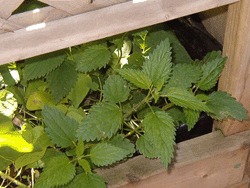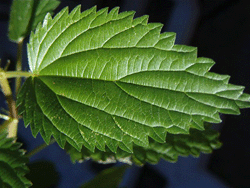 |
|||||
 |
 |
 |
 |
 |
 |
 |
Herb of the Season: Stinging Nettle |
||||
 Do you have a patch of nettle in your garden or neighbourhood green space? Consider it a gift and green ally extraordinaire! They add lush green and wild beauty to your garden where they can grow up to four feet in sunny locations. Nettle leaves are loaded with calcium, Vitamin C, potassium, protein, silica and iron. They’re also a good source of antioxidants including beta carotene, selenium and lycopene. Think of nettles as food for your adrenal glands, which work hard in these high stress times. Nettle is known as a tonic herb restoring tone to the respiratory, endocrine, cardiovascular, digestive, musculoskeletal, urinary and immune systems... an absolutely amazing plant!! Over the years nettle leaf has been the primary focus of my studies but last summer I enjoyed hearing Stephen Buhner lecture on the virtues of nettle root for enhancing men’s health at middle age. His research shows that nettle root tincture helps keep testosterone levels high, decreases urinary aggravations associated with prostate problems and inhibits prostate cancer cell growth. Men should consider using this preparation as a preventative prostate tonic. Please consult the tincture making process in the Herbal Health Root under Herbal Preparations if you’d like to make your own high quality product.  Nettle can be used for a variety of extrinsic remedies as well. I’ve never tried the folkloric “urtication” process of lashing arthritic joints with stinging nettle in order to increase mobility, but I have used nettle infusion as a hair rinse and was pleasantly surprised to read in James Duke’s Phytochemical and Ethnobotanical Database (www.ars-grin.gov/duke) that sulfur (1200-6665 ppm found in nettle leaves) has been identified as an antigreying and antidandruff agent! Clip your nettle frequently, before it flowers (the same way you would harvest mint or basil, just above new growth) and you’ll have a great source of food and medicine all summer long. Hang your nettle in small bunches out of direct sunlight, or spread them onto large wicker baskets, until they’re completely dry. Then store them in a paper bag to further reduce the chance of any moisture settling in. Over the coming months, add the dried nettles to your nourishing herbal infusions to prevent or overcome fatigue and exhaustion, headaches, allergies, or hay fever.   If you’ve mowed over your nettle patch recently, or it’s still young and less than 6 inches in height, pick the ultra-nourishing leaves (with gloves on.. they do sting!) and substitute them for spinach in your favourite recipe, or benefit from making this version of “nettle-kopita”. Cooking the nettle eliminates the sting making it a delicious, re-energizing, free food everyone can take advantage of! I try to get to my local nettle patch every June in order to make this dish at least once through the growing season. It’s a great potluck item, brimming with green delight, well-worth sharing with family and friends. ENJOY!
Wash and stem (less than 4 inch nettle may not need stemming, older definitely does!)) 2 lbs/ 1 kg of nettle in cold water and shake lightly. Put the wet nettle in a large pot and cook for five minutes. Salt lightly. |
|||||
 | |||||
|
Over the years I have been blessed with many inspirational teachers. I thank them for sharing their wisdom through their lectures, workshops, websites and books. For more information about Stinging Nettle and many other herbs, enjoy these insightful and informative resources. | |||||
| Sacred and Herbal Healing Beers by Stephen H. Buhner |
(Sirus Books, 1998) |
||||
| Opening our Wild Hearts to the Healing Herbs by Gail Faith Edwards |
(Ash Tree Publishing, 2000) Click for website | ||||
| Family Herbal by Rosemary Gladstar |
(Storey Books, 2001) Click for website | ||||
| Wise Woman Herbal: Healing Wise by Susun S. Weed | (Ash Tree Publishing, 1989) Click for website |
||||

|
|||||
 ©2025 Monica Giacomin ©2025 Monica Giacomin |
|||||